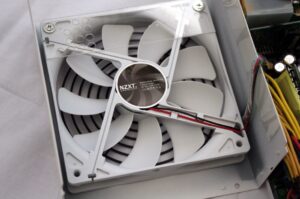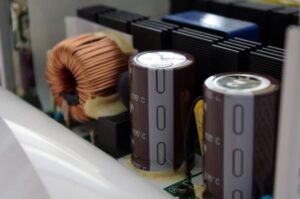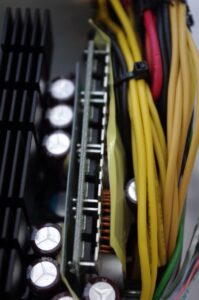NZXT HALE90 750W Power Supply Unit Review
Jake Sedge / 13 years ago
This is where we take a quick peek into the internals of the PSU which is one of the best ways to judge the quality of the PSU. We would not recommend doing this yourself as it will not only void your warranty, but the capacitors inside a PSU can hold a dangerous charge for a long time- we open it up so you don’t have to!
The first thing you see when you open up a power supply is the fan. Normally, the fan is just a generic unbranded model, but NZXT has furnished the HALE90 with their own 140mm fan which, at 100% speed, will only reach 20 dBA at 100% load- which is fantastic. Many of us are careful when choosing case fans, only for a PSU or graphics card fan to ruin the silence! It is great that NZXT has considered silent users.
This fan will be cooling the heatsinks to make sure that the MOSFET transistors, voltage regulators etc. run nice and cool- MOSFET transistors are a lot more sensitive to heat than a CPU and the results of overheating can be literally explosive. Often, as I have seen in previous PSUs I’ve reviewed, companies have skimped and have provided a low quality heatsink- this isn’t going to damage your PSU, but it will force your fan to spin at a higher RPM than is necessary because the cooling solution is inefficient. The heatink on the HALE90 is both high quality and well placed, which is fantastic to see. With this being an 80+ Gold unit, less heat is produced than on, say, an 80+ Bronze PSU because less of the energy being drawn from the unit is wasted as heat which means less heat to dissipate, so this should be a very cool and quiet unit.
The first stage inside a PSU is the transient filtering. This is where the unit filters the AC power coming from the mains so there is less noise which is extremely important, which is partly the reason you see people investing hundreds of pounds in UPS systems which do the same thing (among other things!). To do this, a system of capacitors, ferrite coils and a metal oxide varistor is used. The quality of this stage is determined by the number of components doing the filtering. Many generic units will only have a singular capacitor or won’t have a metal oxide varistor. The HALE90 as expected, has a high quality transient filtering stage consisting of three capacitors and one coil.
These are the main capacitors, every capacitor in the unit is manufactured by Nippon Chemicon whose caps are used in most high end PSUs. Having good quality caps increases longevity and minimises the chance of them leaking or exploding when exposed to high temperatures.
In this shot you can see the VRM which manages all the 5V and 3.3V power on the right and the secondary heatsink with lots of capacitors in the middle. The topography of this unit is great!
Finally, taking a look at the modular daughterboard, we can see that they have included some filtering caps and although the quality of the soldering isn’t excellent, this is only the daughterboard which requires a lot less precision than the main PCB itself where the quality of soldering is a lot higher.

























